Welcome all!
As I have been doing for the last few weeks, I want begin my post this week sharing a reflection on the issue of physician assisted suicide.
The slippery slope of assisted suicide
Proponents of physician-assisted suicide tell us that there is no danger of a slippery slope, that in Oregon the cases are “not that numerous” and are “carefully monitored.” I hope that reasonable people will question these claims and reflect further on whether a law with insufficient safeguards is what we want in the commonwealth.
Slippery slope arguments involve small decisions that lead to undesirable outcomes that never would have been supported at the outset. Often, it is impossible to prove that one small step will have significant negative effects, but common sense allows reasonable people to judge the likelihood that a sequence of events that have happened in one place are likely to happen in another place in a similar way.
Question 2 proposes to allow physician-assisted suicide for those diagnosed with a terminal illness with six months or less to live. Many groups are concerned that, if passed, it not only would be harmful in itself, but could lead to unintended tragic outcomes. (1) Elder advocates are concerned that it could become a new form of elder abuse. (2) Advocates for the disabled are concerned it could lead to “quality of life” standards in our society, where those with a lower perceived quality of life receive fewer benefits or protections. (3) Doctors and nurses are concerned it could lead to a lower “quality of care” for those at the end of life. (4) Doctors are also concerned that it could undermine the doctor-patient relationship. (5) Ethicists are concerned that it could lead to a devaluing of human life. (6) Suicide-prevention organizations are concerned that the state legally allowing suicide for one group (those with terminal diagnoses of fewer than six months to live) could lead to increased suicide rates for the rest of the population. (7) Those who have studied the evolution of this matter in the Netherlands are concerned that assisted suicide could lead, first to voluntary euthanasia (requesting direct help to end one’s life), and then to involuntary euthanasia (where a third-party determines that, if the patient were in his right mind, he would choose euthanasia).
Asserting that something could happen is not the same as stating that something will happen. Here are some facts that lead the groups above to be concerned. Please judge for yourself whether you agree with the risk that one or all of these concerns might occur in Massachusetts if we took the first step this Election Day by voting to legalize assisted suicide.
It could lead to increased elder abuse: Data on the crime of elder abuse show that perpetrators are frequently a spouse or an adult relative. Question 2 does not have safeguards to prevent an unscrupulous heir or indifferent family member from pressuring a sick person, either directly or in subtle ways, to end his or her life. That hardly gives sick people “greater freedom” and “enhanced autonomy” at the end of their lives.
It could lead to adoption of “quality of life” standards: Advocacy groups for the disabled are concerned that a policy of assisted suicide will inevitably lead to establishing social standards of acceptable life. When “quality of life” becomes more important than life itself, the mentally ill, the disabled, the depressed, and those who cannot defend themselves will be at risk of being targeted for assisted suicide, and perhaps eventually, for euthanasia. They fear that misunderstandings and false compassion could result in their being considered “better off dead,” devalued, and treated as second class citizens in respect to their medical care.
It could lead to lower quality of care: Doctors’ and nurses’ groups have expressed concern that efforts to enhance hospice and palliative care will be weakened if a “lazy” path to end-of-life care like physician-assisted-suicide is chosen by voters. They share grave concerns that medical cost-containment pressures will lead to a preference for a $100 prescription for lethal drugs over more expensive treatments.
It could undermine the doctor-patient relationship: The American Medical Association (AMA) and Massachusetts Medical Society oppose physician assisted suicide because it violates the Hippocratic Oath to “do no harm” and changes the nature of the doctor’s role of healing and comforting the patient. The AMA stated “Physician-assisted suicide is fundamentally incompatible with the physician’s role as healer, would be difficult or impossible to control, and would pose serious societal risks.” The goal of medicine is to heal and to cure and, where that is not possible, to comfort the patient. Doctors are expected to act always in the best interests of the patient. Dr. Leon Kass, former chair of the President’s Council on Bioethics, asks the following common sense question: “Will doctors be able to care wholeheartedly for patients when it is always possible to think of killing them as a ‘therapeutic option?’“ In Holland, reports have been published documenting the sad fact that elderly patients, out of fear of euthanasia, refuse hospitalization and even avoid consulting doctors. Dutch citizens have begun to fear that their doctors, instead of being caregivers, will become their executioners.
It could lead to a devaluing of human life: “Taking life in the name of compassion also invites a slippery slope toward ending the lives of people with non-terminal conditions. Dutch doctors, who once limited euthanasia to terminally ill patients, now provide lethal drugs to people with chronic illnesses and disabilities, mental illness, and even melancholy. Once they convinced themselves that ending a short life can be an act of compassion, it was morbidly logical to conclude that ending a longer life may show even more compassion. Psychologically, as well, the physician who has begun to offer death as a solution for some illnesses is tempted to view it as the answer for an ever-broader range of problems.” (USCCB, To Live Each Day with Dignity)
It could lead to an increase of suicide generally: Oregon, the first state to legalize physician-assisted suicide, has one of the highest rates of suicide (not including deaths from PAS) of any state in the nation. It begs a logical question: How can a state effectively both try to minimize suicide in some situations and promote it as a legal alternative in other situations? Is it reasonable to expect that efforts to prevent suicides will be undermined by legalizing suicide and presenting it as normal and acceptable for those with terminal diagnoses?
It could lead, eventually, to euthanasia — like it has in the Netherlands: It is very sobering to see the evolution of physician-assisted suicide in the Netherlands, a modern industrialized country. In 1973 the “Right to Die — NL” was founded and euthanasia has been legal in the Netherlands for more than a decade. The New York Times reported in their April 3, 2012, edition that “Right to Die — NL” is campaigning for expanded euthanasia, in the form of mobile teams to go out to people’s homes to euthanize them. They are also promoting the idea that euthanasia should no longer be limited just to the terminally ill, and their proposal envisions the service for any individual over 70 years of age who requests it.
The Dutch patients’ organization, NPV, strongly criticizes the current application of the law, saying the practice of euthanasia has been extended to include patients with dementia and other conditions who may not, by definition, be competent to request help in dying, including children. Elise Van Hock-Burgerhart, a spokeswoman for NPV, told the New York Times reporter that the idea of mobile euthanasia teams was a matter of concern because there was no way for the mobile team doctors to get to know the patients. Moreover, she stated that research in the Netherlands indicated that requests for euthanasia from the elderly would be substantially reduced if palliative care were better in their country and that the country should be working toward improving palliative care, not increasing euthanasia. She also indicated that the law in the Netherlands required review committees to sign off on every reported case of euthanasia, but that 469 cases from 2010 had still not been reviewed; 2010 is the latest year for which data is available. That year 3,136 notifications of termination of life on request were reported, indicating that it was not clear how well doctors were adhering to the official guidelines. Anyone that believes that a “slippery slope” doesn’t exist with assisted suicide and euthanasia only has to look at its “evolution” in the Netherlands.
In the United States we are still a long way from the Dutch situation; however, this is not because the laws in the two states that allow PAS are well written or because of careful oversight. What has put the brakes on the growth of physician-assisted suicide in the U.S. is that more than 20 states have rejected proposed legislation and ballot initiatives.
Now it is our turn in Massachusetts to stop this bad idea and bad law from going into effect. Please join me to stop assisted suicide by voting “No on Question 2” on Election Day.
– – –
When I was bishop in the West Indies, we enjoyed a close friendship among the handful of clergy on our island. When the rabbi was departing for a new posting, we had a going away lunch in his honor. During the meal, there was a sudden tropical downpour, and water began to drip right on the rabbi’s head. Rabbi Relkin had a great sense of humor and immediately exclaimed, “I knew that you guys would try to baptize me before I got out of this place.”
There was a time and place when Catholics may have tried to “force their religion on others.” It is certainly not a contemporary phenomenon. In fact, the Church has come to see “forcing our religion on others” as a violation of our own religious principles. I was distressed by one of the answers given during the recent political debates when one of the candidates indicated that, although he believed the Church’s teaching on abortion, he could not “impose his Catholicism on others.” This is one of the themes I dealt with in my recent Red Mass homily.
Defending human life is not a sectarian or simply a Catholic thing. Everyone, regardless of their religious persuasion or lack of it, has an obligation to defend human life, and promote human dignity. Many people criticized Monseñor Oscar Romero for preaching against the exploitation of the poor, many were hostile to Martin Luther King for preaching on civil rights. No one would say, ”I am against perjury but I would not impose my religion on others," or “I am against human trafficking but I would not impose my religion on others.” Defending the most vulnerable in our society is not just a Catholic thing, and it is certainly not like imposing our religion on others.
I want to share with you my homily from the Red Mass for members of the legal professions that I spoke of last week.
– – –
Now, on to the events of my week:
Last Thursday, we had one of our regular meetings of the board of the Massachusetts Catholic Conference. The MCC is the joint public policy voice of the four Catholic dioceses of Massachusetts. They play a very important role on the issue of education and other important issues.
During the meeting, we planned activities for the upcoming year. MCC director Jim Driscoll gave us a report on the issues relevant to the Church likely to come up in the upcoming year.
– – –
On Friday, October 5, I celebrated the funeral Mass for Father Richard Butler.
In my comments, I mentioned that there are many prayers that talk about being welcomed into heaven by the poor that we have befriended during our lifetime. Certainly, this is something that Father Richard Butler could look forward to as he was very focused on the social gospel of the Church. He was a friend of Dorothy Day’s, served on the board of many community organizations and made over 30 trips to Haiti.
He was also very much interested in the liturgy and very much involved in that ministry.
The large number of priests, relatives, friends and loved ones who were there to say goodbye to him was a great testimony to the impact his life had.
Father Butler’s identical twin, who is also a priest of the archdiocese, Father Robert Butler spoke at the end of Mass.
– – –
On Saturday, I was happy to celebrate the diaconal ordination of a number of Jesuits and a member of the Redemptorist order.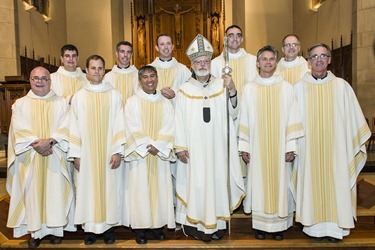
The Mass was held at St. Ignatius Church in Chestnut Hill. The Redemptorist deacon is from the island of Grenada in the West Indies. I told him that I was ordained a bishop by a Redemptorist Bishop in the West Indies, so I was happy to return the favor!
I told them it was the Feast of St. Bruno and also the date that the first Jesuit arrived in United States. His name was Pedro Martinez (though not the former Red Sox pitcher, I told them!) and he was martyred in Florida.
I told them it was a very auspicious date to celebrate the ordination of these young Jesuits from various provinces, including one from Singapore.
– – –
Then, I took advantage of the rest of the holiday weekend to visit my step mother, Claire O’Malley, who is still in rehab in Boca Raton, Florida. For that reason, I was unable to celebrate the annual Mass for Respect Life Sunday.
I am grateful to Father Kevin O’Leary who acted as the main celebrant in my place. I am also grateful to Deacon Tim Maher who preached the homily. Deacon Maher is the deacon at St. Jerome in Weymouth, is currently assigned to the Pro-Life Office and is part of the educational team that is giving talks at parishes on the issue of physician assisted suicide.
– – –
On Tuesday, I was visited by a number of members of the Priestly Fraternity of St. Charles Borromeo. Their community has come out of Msgr. Luigi Giussani’s movement, Communion and Liberation. We are very blessed by their presence here, as well as consecrated lay people who belong to what is called the Memores Domini. Members of the priestly fraternity are teaching here in the archdiocese of Boston, such as Father Jose Medina, the head of the Cristo Rey School in Dorchester.
I also congratulated them because their founder, Bishop-elect Massimo Camisasca, has just been named the bishop of the Diocese of Reggio Emilia, Italy.
– – –
Then, in the afternoon, I went to the headquarters of the Greek Orthodox Metropolis of Boston for a meeting with local religious leaders to discuss how we might collaborate in opposing the ballot question to legalize physician assisted suicide in Massachusetts. 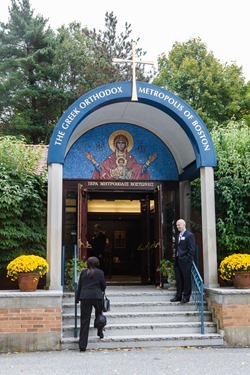
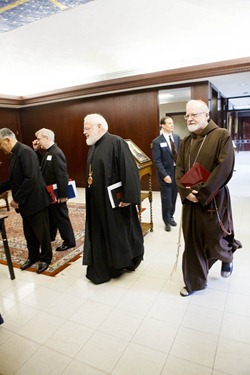
At the meeting we spoke about the need to inform our people about the ballot initiative.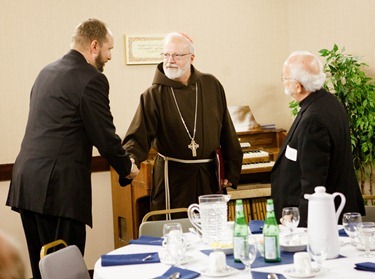
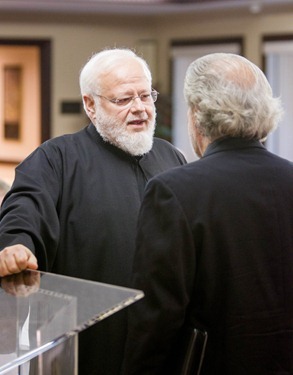
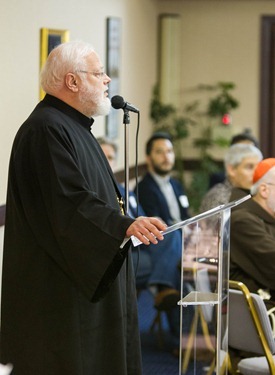
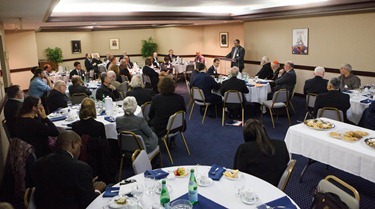
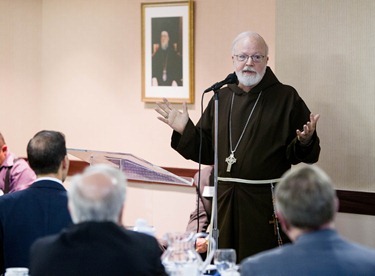
We had a wonderful response from the religious community. There were about 40 different religious groups represented. Unfortunately, many local rabbis who would have liked to attend could not because they were celebrating a high holy day. It certainly demonstrated that this is not just a Catholic issue, and that a large number of the religious communities in Massachusetts are very engaged on this issue.
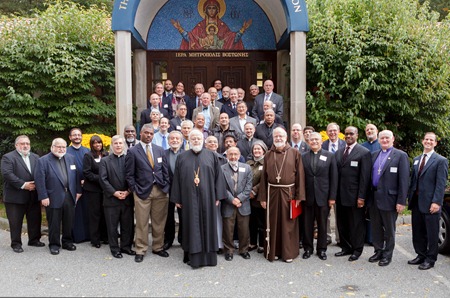
We are very grateful to Metropolitan Methodios for hosting the meeting as well as to Dr. Vito Nicastro and Father David Michael of our Office of Ecumenical and Interreligious Affairs for their work in organizing it.
– – –
From there, I went to the Pope John Paul II Catholic Academy Columbia Road campus for the reception to present John and Cyndy Fish with the academy’s 2012 Eileen and Jack Connors’ Founders Award.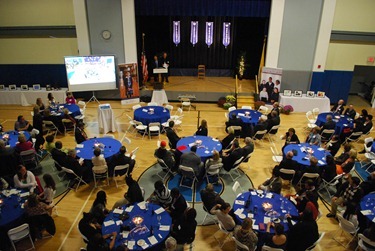
Pope John Paul II Catholic Academy is the largest primary school in Boston, public or private. The building has been beautifully refurbished thanks to the school’s many benefactors and the hard work of John Fish and Suffolk Construction. He was personally involved in the refurbishment of the school as well as Trinity Catholic Academy of Brockton.
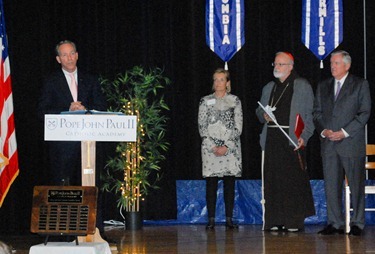
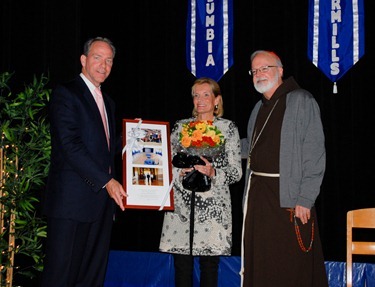
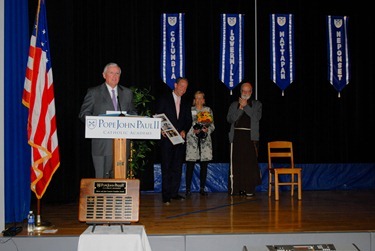
Some of the largest benefactors of Catholic education in the archdiocese were present to honor him for his work: Peter Lynch, Jack Connors, Tom Shields, Jim Gallagher, Bob Atchinson, Jim Healey and Maureen Bleday of the Yawkey Foundation and Joe Petrowski, just to name a few.
The children from the school performed for us and did a wonderful job! They sang Do-Re-Mi from the Sound of Music and then they sang an anthem that has been written for the school.

– – –
Wednesday, we had our semi-annual meeting of the bishops of the Boston Province — Massachusetts New Hampshire, Vermont, and Maine. The gatherings are an opportunity to come together to talk about what is happening in our dioceses, pastoral challenges and the work we are doing.
We have some retired bishops living in the diocese, as well, and one of them is Bishop McNaughton, who went to Rome for the opening of the Year of Faith because he is one of the few surviving bishops who was actually in attendance at the second Vatican Council. He was just a new Bishop at the time.
– – – 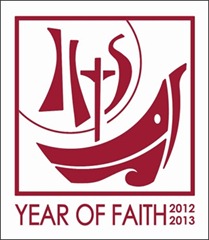
I was very pleased at the wonderful response to our invitation from the Priest Council and other priests, auxiliary bishops and many of the faithful to gather with members of our staff for the televised Mass yesterday to open the Year of Faith.
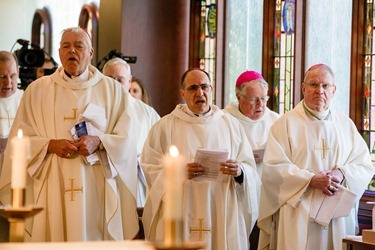
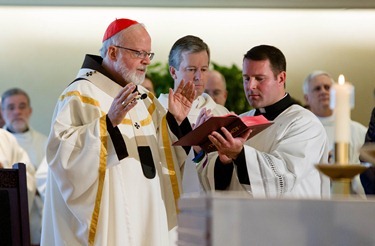
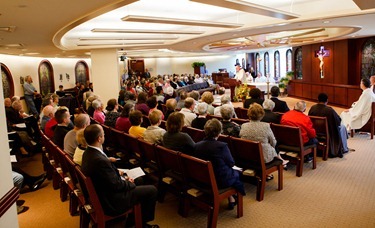
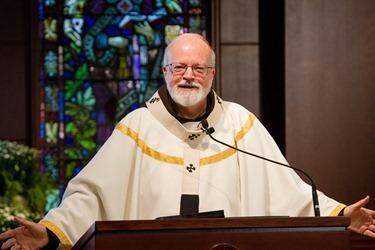
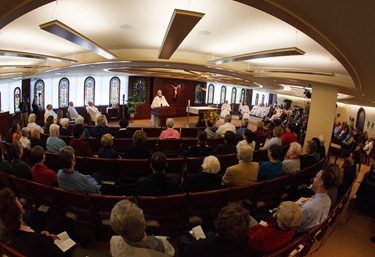
The date was the Feast of Blessed John XXIII and the 50th anniversary of the Second Vatican Council and the 20th anniversary of the Catechism of the Catholic Church.
The year of Faith, which the Holy Father opened in Rome, is an important opportunity for all of us to renew our commitments to the task of evangelization beginning with the deepening of our own knowledge of the faith and our commitment to the mission that Christ has entrusted to us in the Church.
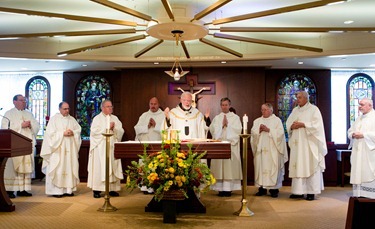
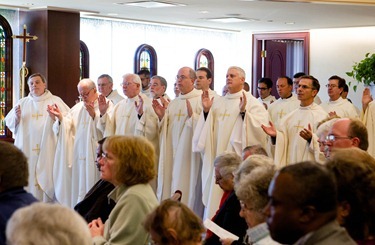
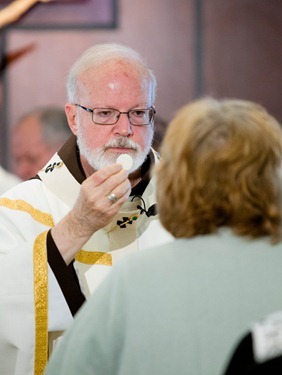
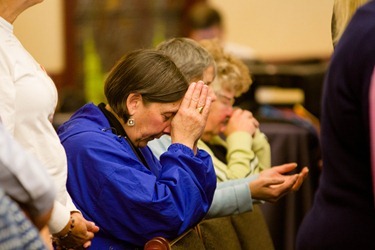
During the Mass, we asked the people to join us praying a special prayer for the New Evangelization for the Year of Faith.
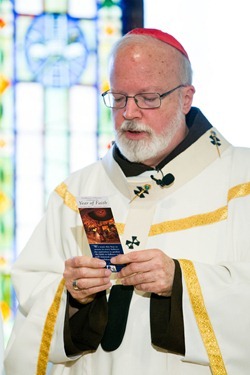
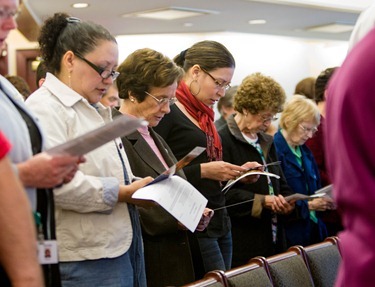
As part of our effort to take advantage of technology as part of the process of New Evangelization, I will be tweeting regularly, particularly during this period that is so crucial to try to get out the message about the physician assisted suicide ballot measure. I invite you to follow me @cardinalsean .
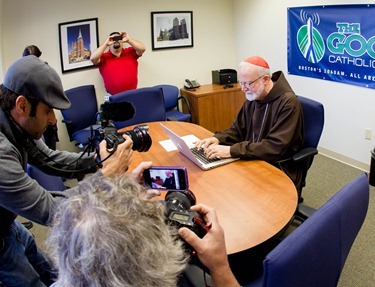
We invited members of the media to be present as I sent out a Twitter message after the Mass

Until next week,
Cardinal Seán
